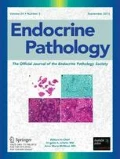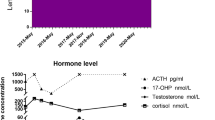Abstract
Bilateral testicular tumors are a rare complication of congenital adrenal hyperplasia. It can be extremely difficult to distinguish histologically between Leydig cell tumors and adrenocortical rest hyperplasia, which may lead in some cases to unnecessary orchidectomy. A 7-yr-old boy was admitted because of precocious puberty and enlargement of testicles. Hormonal studies established the diagnosis of congenital adrenal hyperplasia due to 21-hydroxylase deficiency. Testicular biopsy revealed interlacing strands, cords, and rests of cells resembling interstitial (Leydig) cells but with no Reinke crystalloids. Here we report a case of testicular adrenal rest hyperplasia in congenital adrenal hyperplasia and discuss the pathological and clinical features and origin of this rare lesion by using immunohistochemical evaluation.
Similar content being viewed by others
References
Avila NA, Shawker TS, Jones JV, Cutler GB, Merke DP. Testicular adrenal rest tissue in congenital adrenal hyperplasia: Serial sonographic and clinical findings. AJR 172:1235–1238, 1999.
Miller WL. Pathophysiology, genetics and treatment of hyperandrogenism. Pediatr Endocrinol 2:375–395, 1997.
Al-Alwan I, Navarro O, Daneman D, Daneman A. Clinical utility of adrenal ultrasonography in the diagnosis of congenital adrenal hyperplasia. J Pediatr 135:71–75, 1999.
Wilson BE, Netzloff ML. Primary testicular abnormalities causing precocious puberty, Leydig cell tumor, Leydig cell hyperplasia and adrenal rest tumor. Ann Clin Lab Sci 13:315, 1983.
Clark RV, Albertson BD, Munabi A, et al. Steroidogenic enzyme activities, morphology and receptor studies of a testicular adrenal rest in a patient with congenital adrenal hyperplasia. J Clin Endocrinol Metab 70:1408–1413, 1990.
Srikanth MS, West BR, Ishitani M, Isaacs H, Applebaum H, Costin G. Benign testicular tumors in children with congenital adrenal hyperplasia. J Pediatr Surg 27(5):639–641, 1992.
Rich MA, Keating MA, Levin HS, Kay R. Tumors of the adrenogenital syndrome: an aggressive conservative approach. J Urol 160:1838–1841, 1998.
Benvenga S, Smedile G, Giudice FL, Trimarchi F. Testicular adrenal rests: evidence for luteinizing hormone receptors and for distinct types of testicular nodules differing for their autonomization. Eur J Endocrinol 141:231–237, 1999.
Stikkelbroeck NM, Otten BJ, Pasic A, et al. High prevalence of testicular adrenal rest tumors, impaired spermatogenesis and leydig cell failure in adolescent and adult males with congenital adrenal hyperplasia. J Clin Endocrinol 86(12):5721–5728, 2001.
Author information
Authors and Affiliations
Corresponding author
Rights and permissions
About this article
Cite this article
Erdogan, S., Ergin, M., Cevlik, F. et al. Testicular adrenal rest hyperplasia due to 21-hydroxylase deficiency: A case report. Endocr Pathol 17, 83–88 (2006). https://doi.org/10.1385/EP:17:1:83
Issue Date:
DOI: https://doi.org/10.1385/EP:17:1:83




